|
CHAPTER VI.
WHAT COLUMBUS DISCOVERED.
The True Story of Christopher Columbus, Called the Great Admiral | ||
6.
CHAPTER VI.
WHAT COLUMBUS DISCOVERED.
A LITTLE over three hundred years ago there was a Pope of Rome whose name was Gregory XIII. He was greatly interested in learning and science, and when the scholars and wise men of his day showed him that a mistake
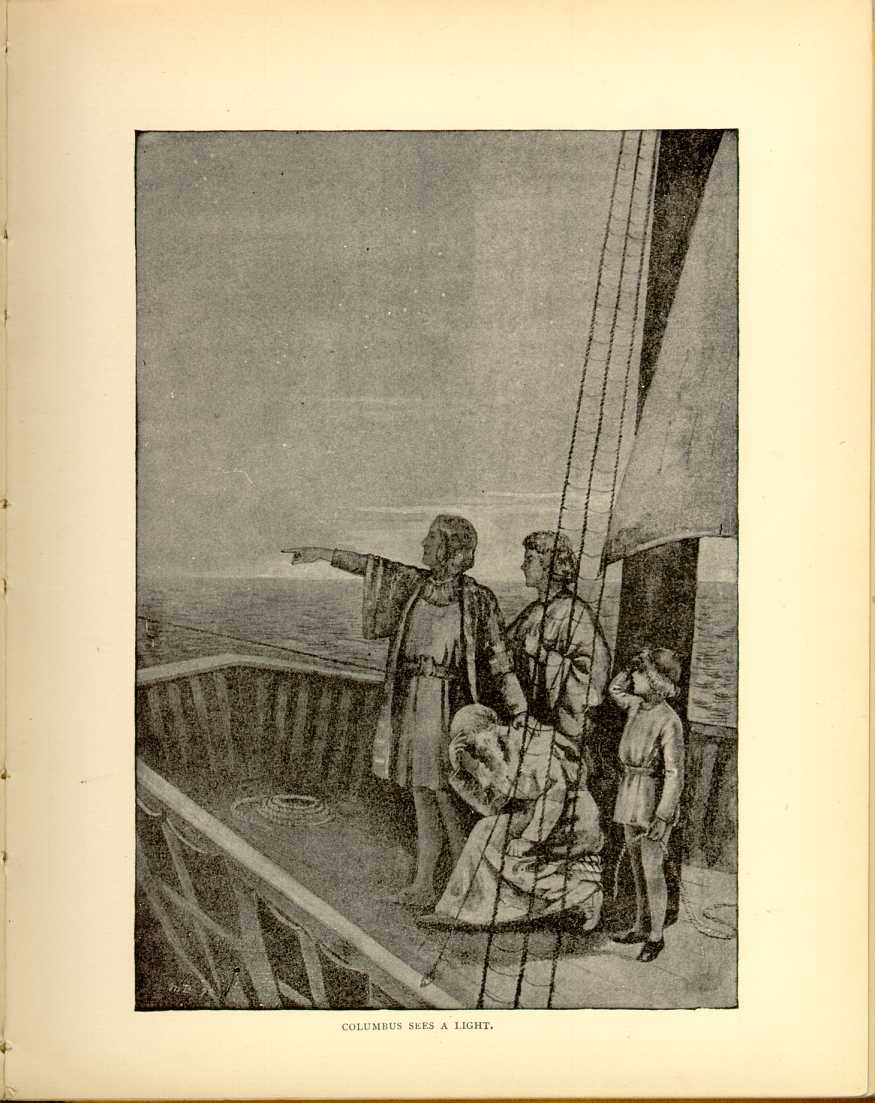
COLUMBUS SEES A LIGHT.
[Description: Drawing of Columbus, his finger pointing, standing at the bow of the ship with several other figures. ]So they all agreed to his plan of renumbering the days of the year, and a new reckoning of time was made upon the rule that most of you know by heart in the old rhyme:
April, June and November;
All the rest have thirty-one,
Excepting February which alone
Hath twenty-eight—and this, in fine,
One year in four hath twenty-nine.
And the order of the days of the months and the year is what is called, after Pope Gregory, the Gregorian Calendar.
This change in reckoning time made, of course, all past dates wrong. The old dates, which were called Old Style, had to be made to correspond with the new dates which were called New Style.
Now, according to the Old Style, Columbus discovered the islands he thought to be the Indies (and which have ever since been called the West Indies) on the twelfth of October, 1492. But, according to the New Style, adopted nearly one hundred years after his discovery, the right date would be the twenty-first of October. And this is why, in the Columbian memorial year of 1892, the world celebrated
But did Columbus discover America? What was this land that greeted his eyes as the daylight came on that Friday morning, and he saw the low green shores that lay ahead of his caravels?
As far as Columbus was concerned he was sure that he had found some one of the outermost islands of Cipango or Japan. So he dropped his anchors, ordered out his rowboat, and prepared to take possession of the land in the name of the queen of Spain, who had helped him in his enterprise.
Just why or by what right a man from one country could sail up to the land belonging to another country and, planting in the ground the flag of his king, could say, "This land belongs to my king!" is a hard question to answer. But there is an old saying that tells us, Might makes right; and the servants of the kings and queens—the adventurers and explorers of old—used to go sailing about the world with this idea in their heads, and as soon as they came to a land they, had never seen before, up would go their flag, and they would say, This land is mine and my king's! They would not of course do this in any of the well-known or "Christian lands" of Europe; but they believed that all "pagan lands" belonged by right to the first European king whose sailors should discover and claim them.
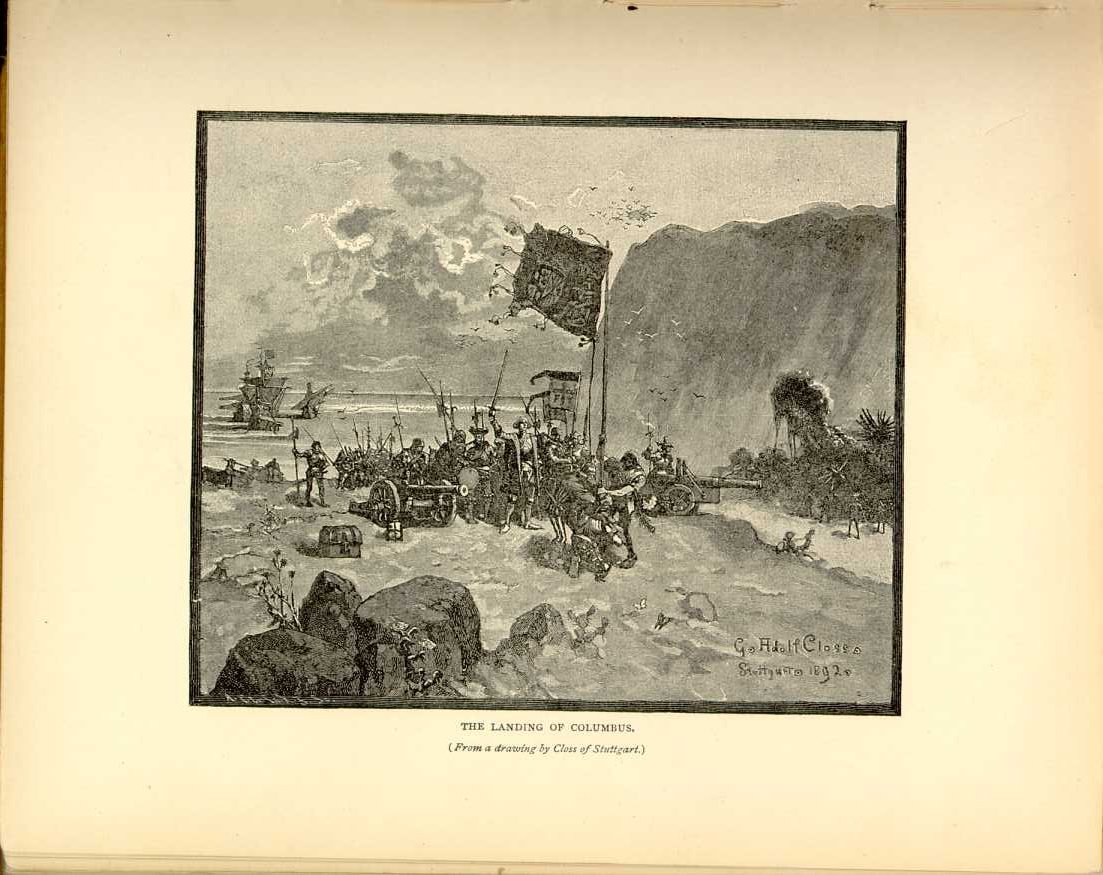
THE LANDING OF COLUMBUS.
(From a drawing by Closs of Stuttgart.)
[Description:
Drawing of Columbus and his men arriving on the shore of an island.
]
So Columbus lowered a boat from the Santa Maria, and with two of his chief men and some sailors for rowers he pulled off toward the island.
But before he did so, he had to listen to the cheers and congratulations of the very sailors who, only a few days before, were ready to kill him. But, you see, this man whom they thought crazy had really brought them to the beautiful land, just as he had promised. It does make such a difference, you know, in what people say whether a thing turns out right or not.
Columbus, as I say, got into his rowboat with his chief inspector and his lawyer. He wore a crimson cloak over his armor, and in his hand he held the royal banner of Spain. Following him came Captain Alonso Pinzon in a rowboat from the Pinta, and in a rowboat from the Nina Captain Vincent Pinzon. Each of these captains carried the "banner of the green cross" on which were to be seen the initials of the king and queen of Spain.
As they rowed toward the land they saw some people on the shore. They were not dressed in the splendid clothes the Spaniards expected to find the people of Cathay wearing. In fact, they did not have on much of anything but grease and paint. And the land showed no signs of the marble temples and gold-roofed palaces the sailors expected to find. It was a little, low, flat green island, partly covered with trees and with what looked like a lake in the center.
This land was, in fact, one of the three thousand keys or
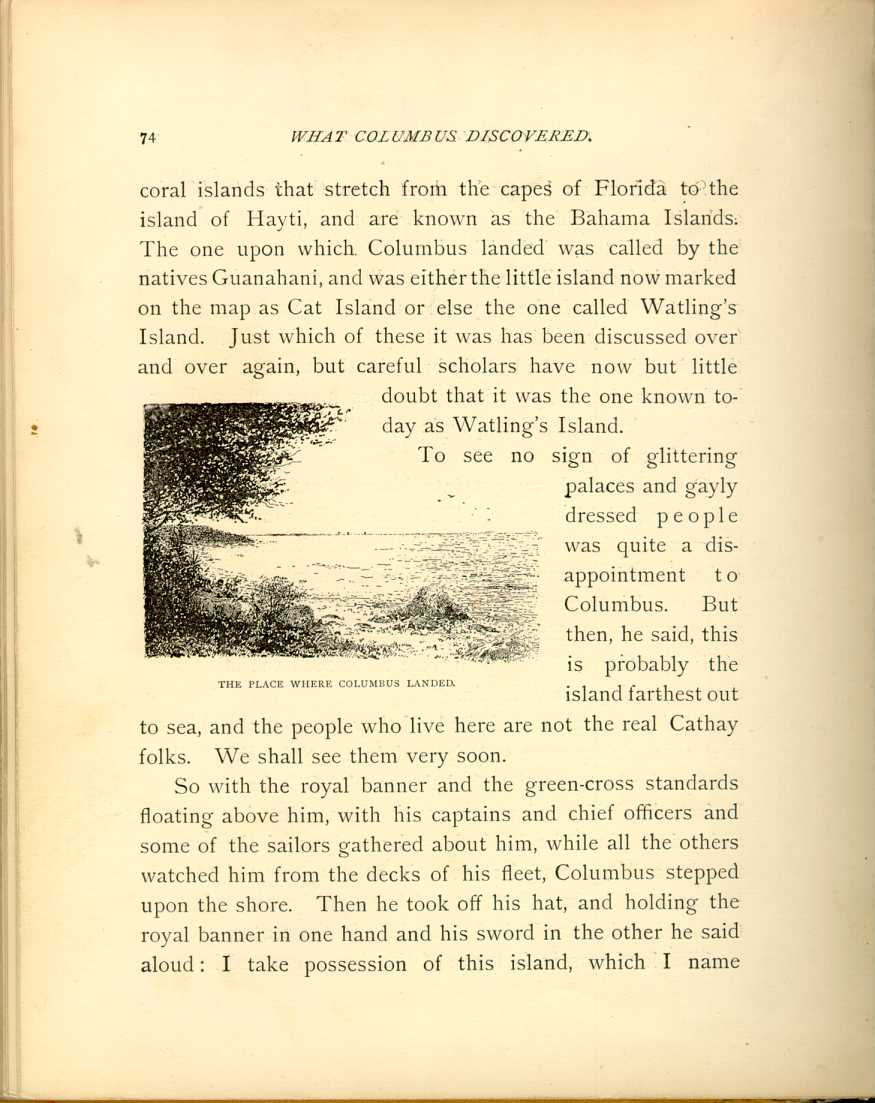
THE PLACE WHERE COLUMBUS LANDED.
[Description: Drawing of the Columbus coming on shore with his men, several flags, and two cannons. ]So with the royal banner and the green-cross standards floating above him, with his captains and chief officers and some of the sailors gathered about him, while all the others watched him from the decks of his fleet, Columbus stepped upon the shore. Then he took off his hat, and holding the royal banner in one hand and his sword in the other he said aloud: I take possession of this island, which I name
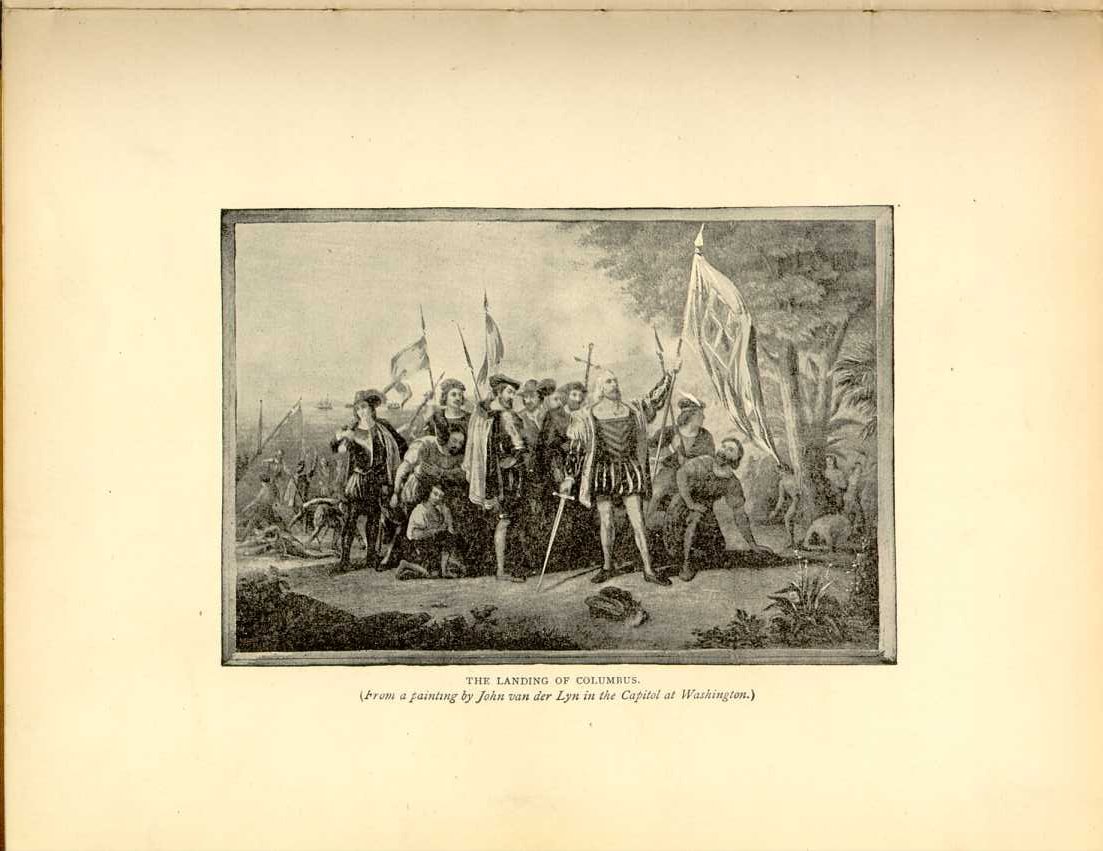
THE LANDING OF COLUMBUS.
(From a painting by John van der Lyn in the Capitol of Washington.)
[Description:
Reprint of a painting depicting Columbus's first landing. Columbus,
surrounded by his men, holds a flag in one hand and a sword pointed to
the ground in the other.
]
And when he had done this the captains and sailors fell at his
feet in wonder and admiration, begging him to forgive them for all the
hard things they had said about him. For you have found Cathay, they
cried. You are our leader. You will make us rich and powerful. Hurrah
for the great Admiral!
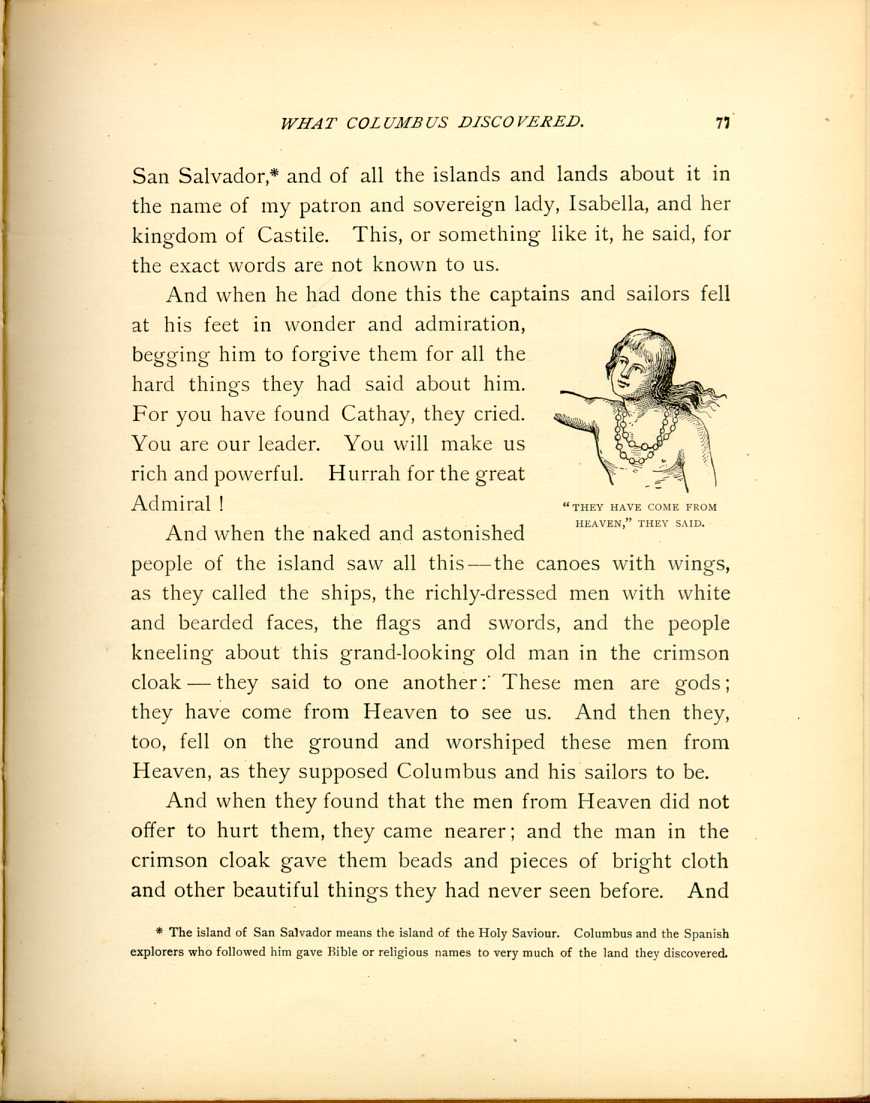
"THEY HAVE COME FROM HEAVEN," THEY SAID.
[Description:
Drawing of one of the native island men wearing two strands of beads
around his neck.
]
And when the naked and astonished people of the island saw all this—the canoes with wings, as they called the ships, the richly-dressed men with white and bearded faces, the flags and swords, and the people kneeling about this grand-looking old man in the crimson cloak—they said to one another: These men are gods; they have come from Heaven to see us. And then, they, too, fell on the ground and worshiped these men from Heaven, as they supposed Columbus and his sailors to be.
And when they found that the men from Heaven did not offer to hurt them, they came nearer; and the man in the crimson cloak gave them beads and pieces of bright cloth and other beautiful things they had never seen before. And
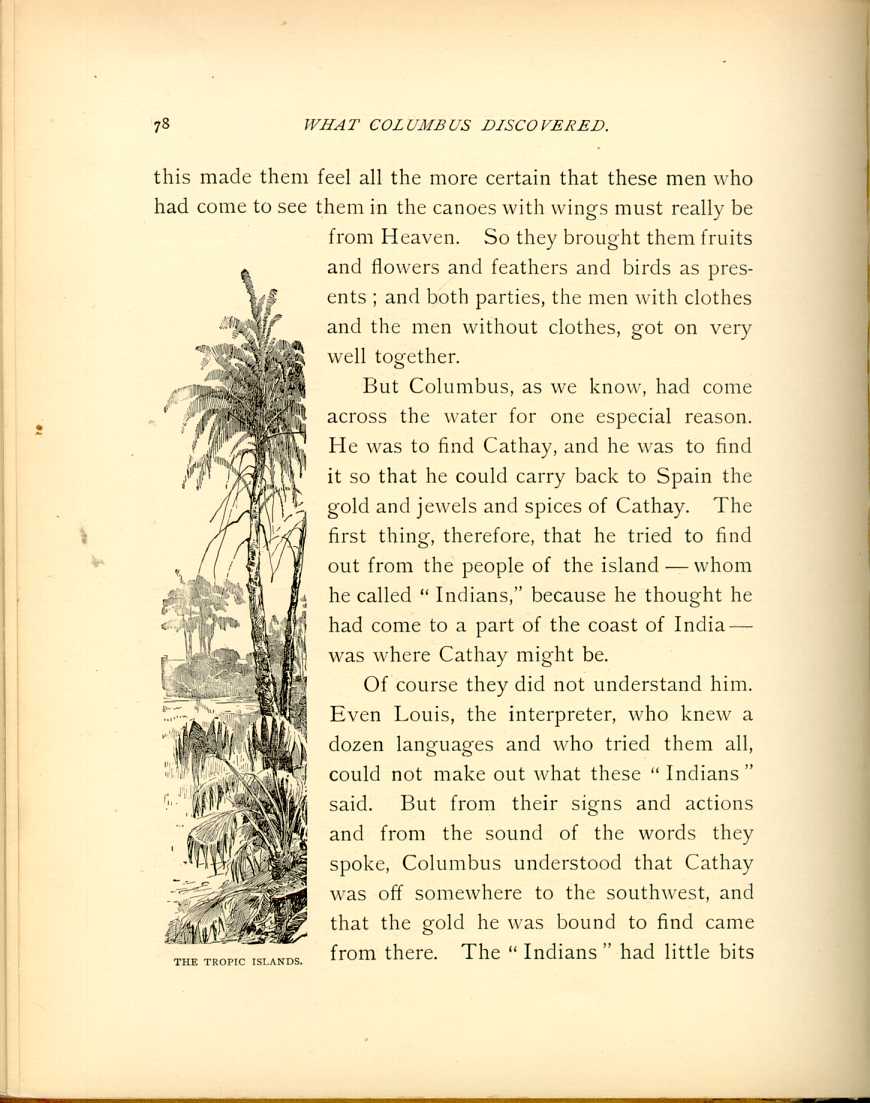
THE TROPIC ISLANDS.
[Description: Drawing of palm trees and other tropical plants. ]But Columbus, as we know, had come across the water for one especial reason. He was to find Cathay, and he was to find it so that he could carry back to Spain the gold and jewels and spices of Cathay. The first thing, therefore, that he tried to find out from the people of the island—whom he called "Indians," because he thought he had come to a part of the coast of India—was where Cathay might be.
Of course they did not understand him. Even Louis, the interpreter, who knew a dozen languages and who tried them all, could not make out what these "Indians" said. But from their signs and actions and from the sound of the words they spoke, Columbus understood that Cathay was off somewhere to the southwest, and that the gold he was bound to find came from there. The "Indians" had little bits
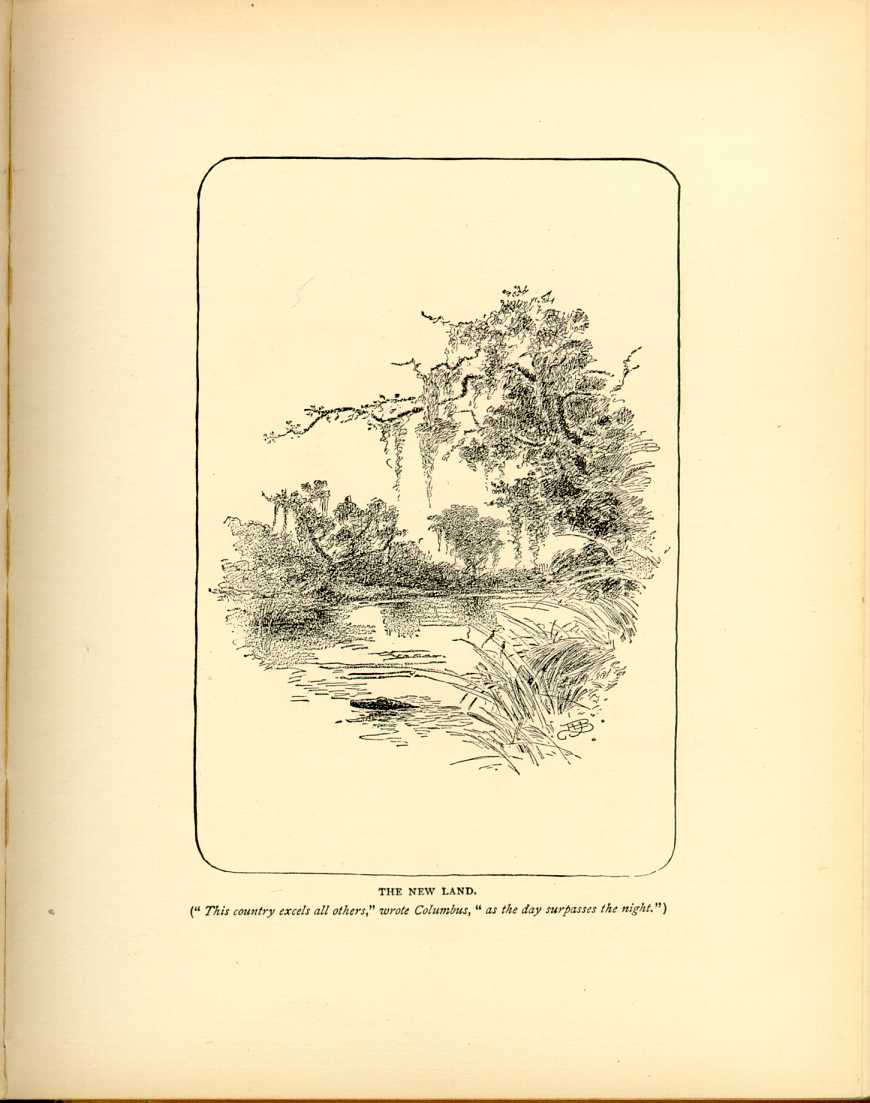
THE NEW LAND.
("This country excels all others," wrote Columbus, "as the day surpasses
the night.")
[Description:
Drawing of a body of water surrounded by tropical flora.
]
The next day Columbus pulled up his anchors, and having seized and carried off to his ships some of the poor natives who had welcomed him so gladly, he commenced a cruise among the islands of the group he had discovered.
Day after day he sailed among these beautiful tropic islands, and of them and of the people who lived upon them he wrote to the king and queen of Spain: "This country excels all others as far as the day surpasses the night in splendor. The natives love their neighbors as themselves; their conversation is the sweetest imaginable; their faces smiling; and so gentle and so affectionate are they, that I swear to Your Highness there is not a better people in the world."
Does it not seem a pity that so great a man should have acted so meanly toward these innocent people who loved and trusted him so? For it was Columbus who first stole them away from their island homes and who first thought of making them slaves to the white men.
The island of San Salvador means the island of the Holy Saviour. Columbus and the Spanish explorers who followed him gave Bible or religious names to very much of the land they discovered.
|
CHAPTER VI.
WHAT COLUMBUS DISCOVERED.
The True Story of Christopher Columbus, Called the Great Admiral | ||